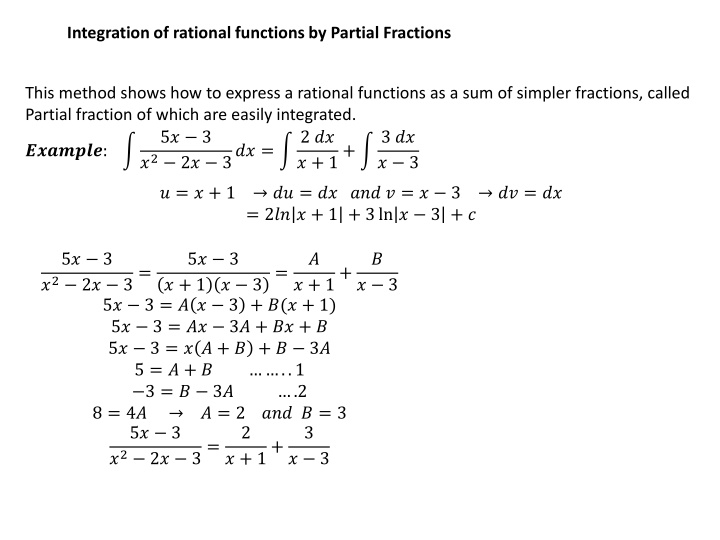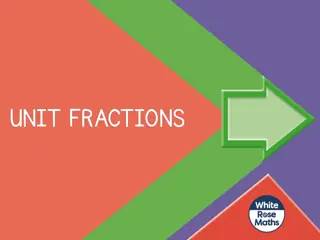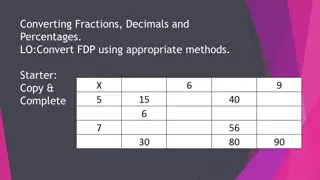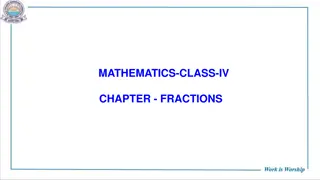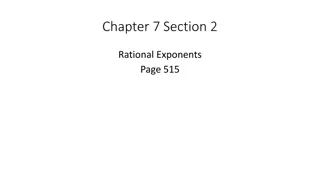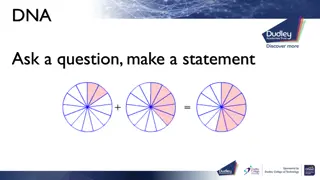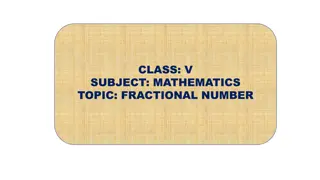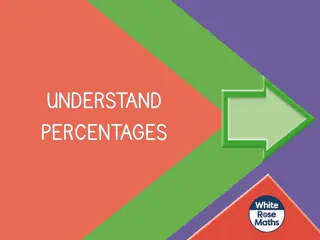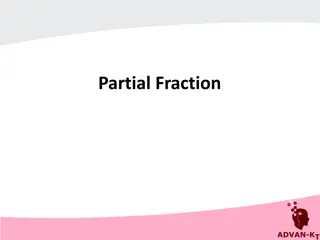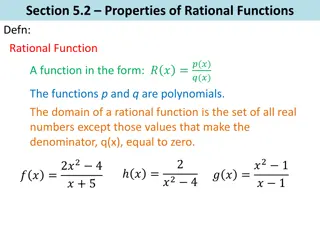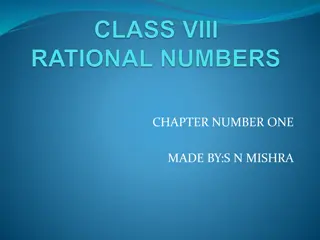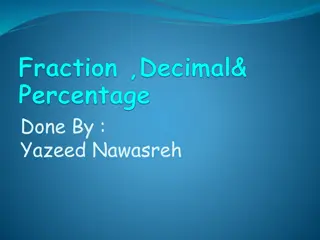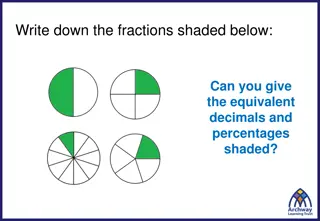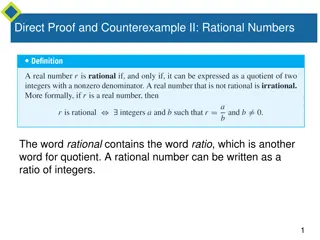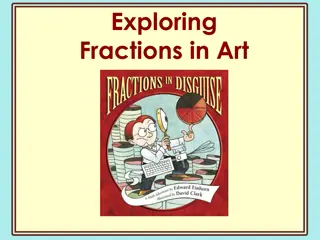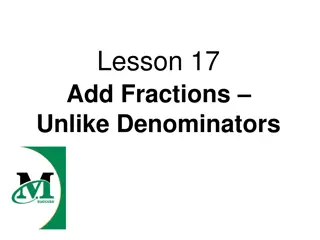Integration of Rational Functions by Partial Fractions
This method demonstrates how to express rational functions as a sum of simpler fractions, making them easier to integrate. It involves decomposing the given function into partial fractions and integrating each component separately. The process is illustrated step by step with examples and mathematical expressions.
Download Presentation

Please find below an Image/Link to download the presentation.
The content on the website is provided AS IS for your information and personal use only. It may not be sold, licensed, or shared on other websites without obtaining consent from the author.If you encounter any issues during the download, it is possible that the publisher has removed the file from their server.
You are allowed to download the files provided on this website for personal or commercial use, subject to the condition that they are used lawfully. All files are the property of their respective owners.
The content on the website is provided AS IS for your information and personal use only. It may not be sold, licensed, or shared on other websites without obtaining consent from the author.
E N D
Presentation Transcript
Integration of rational functions by Partial Fractions This method shows how to express a rational functions as a sum of simpler fractions, called Partial fraction of which are easily integrated. 5? 3 ?2 2? 3?? = 2 ?? ? + 1+ 3 ?? ???????: ? 3 ? = ? + 1 ?? = ?? ??? ? = ? 3 ?? = ?? = 2?? ? + 1 + 3ln ? 3 + ? 5? 3 ?2 2? 3= 5? 3 ? + 1 ? 3 ? ? = ? + 1+ ? 3 5? 3 = ? ? 3 + ?(? + 1) 5? 3 = ?? 3? + ?? + ? 5? 3 = ? ? + ? + ? 3? 5 = ? + ? 3 = ? 3? 8 = 4? ? = 2 ??? ? = 3 5? 3 ?2 2? 3= ..1 .2 2 3 ? + 1+ ? 3
6? + 7 ? + 22 ?? ??????? 6? + 7 ? + 22= 6? + 7 = ? ? + 2 + ? 6? + 7 = ?? + 2? + ? 6 = ? ??? 7 = 2? + ? ? = 5 6? + 7 ? + 22 ?? = 6 ?? ? ? ? + 2+ ? + 22 5 ?? ? + 22 ? + 2 ? = ? + 2 ?? = ?? ??? ? + 2 = ? ?? = ?? = 6 ?? ? + 2 + 5 ? + 2 1+ ? ?? ???????: ???????? ? 2 ?2+ 1 1 ? 2+?? + ? ? = ? 2 ?2+ 1 1 = ? ?2+ 1 + ?? + ? ? 2 1 = ??2+ ? + ??2 2?? + ?? 2? 1 = ?2? + ? + ? ? 2? + ? 2? ? + ? = 0 , ? 2? = 0 ??? 1 = ? 2? ?2+ 1
? =1 ? = 1 5 ??? ? = 2 5 , 5 1 5 1 5? 2 ?2+ 1 1 5 = ? 2+ ? 2 ?2+ 1 ?? =1 ? 2 1 ?? ??? ?2+ 1 2 ?? 5 5 5 ? 2 ?2+ 1 ?2+ 1 ?? ? 2= ln ? 2 , ? = ? 2 ?? = ?? ??? ?2+ 1=1 2?? ?2+ 1 , ? = ?2+ 1 ?? = 2??? ?? ?2+ 1= ??? 1? ,? = tan? ?? = ???2??? ???2??? ???2? = ?? = ? = ??? 1? ?? =1 10?? ?2+ 1 2 1 5??? 1? + ? 5?? ? 2 ? 2 ?2+ 1
?? ???????: ? ?2+ 12 ? ?2+ 12=? 1 = ? ?2+ 12+ ? ?2+ 1 ?? + ? + ?(?? + ?) 1 = ? ?4+ 2?2+ 1 + ? ??3+ ??2+ ?? + ? + ??2+ ?? 1 = ??4+ 2??2+ ? + ??4+ ??3+ ??2+ ?? + ??2+ ?? 1 = ? + ? ?4+ ??3+ 2? + ? + ? ?2+ ? + ? ? + ? ? + ? = 0 , ? = 0 , 2? + ? + ? = 0 , ? = 1 , ? = 1, 1 ? ?2+ 12=1 1 ?+?? + ? ?? + ? ?2+ 12 ?2+ 1+ ? + ? = 0, ? = 0 ? ?2+ 12 ? = 1 ? ?+ ?2+ 1+ ? ?2+ 12= ?? ?? ? ? ? ?2+ 1?? ?2+ 12 ?? ? = ?2+ 1 ?? = 2??? = ?? ? 1 2?? ?2+ 1 +1 ? ?2+ 1+ 1 ?2+ 1+ ? 2 1 = ?? 2(?2+ 1)+ ?
Numerical Integration Integration two such methods, the Trapezoidal Rule and Simpson s Rule. Trapezoidal Approximation It is based on approximating the region between a curve and the x-axis with trapezoids instead of rectangles as in figure. The length of each subinterval is ? =? ? = ???? ???? ? The area of the trapezoid that lies above the ith Subinterval is ? = ? 2(??+ 2?1+ 2?2+ + ??)
2?2?? . Compare the estimate with Example: Use the Trapezoidal Rule with n=4 to estimate 1 the exact value. ? =2 1 =1 ? = ?2 ? 1 5 4 6 4 7 4 2 4 4 4 1 ? = ? 2(??+ 2?1+ 2?2+ 2?3+ ?4) 25 16 16 81 +110 8 8 25 16 =1 36 41 16 36 16 49 16 81 + 2 + 2 + 2 + 4 =1 + 4 =1 150 8 =150 64= 2.34375 2 2 ?3 3 =7 ?2?? = ????? ???????? 3 1 1 2.34375 7 7 3 3 = 0.00446 ?? 0.446% Percent error=
? = 3??+ 4?1+ 2?2+ 4?3+ 2?4+ + ?? Example: Use Simpson s Rule with n=4 to approximate 25?4?? ? =2 0 0 =1 ? = 5?4 ? 0 0 1/2 5/16 1 5 3/2 405/16 2 80 4 2 ? = 3(??+ 4?1+ 2?2+ 4?3+ ?4) 5 16 = 321 12 =1 405 16 60 + 4 + 2 5 + 4 + 80
Improper Integrals The integral for the area under the curve of ? = 1 ? between x=0 and x=1 is an example for which the range of integrand is infinite. This integral is said to be improper and is calculated as limit . Example: Is the area under the curve ? =ln ? ?2from x=1 to x= finite? If so, what its value? ln? ?2?? = lim ?ln? ?2?? ? 1 1 ?? =?? ? = 1 ? = ln? , ?? =1 ? ? 1 ?ln? 1 ?2 = ?2?? 1 1 1 ? , ? ? = 1 1 ?1 = ln? ?ln? ?+ 1 ? 1 ? 1 0 + 1 = 1 ln? 1 lim ? ?+ 1 = ?
0 ?? ?? ?? 1 + ?2= 1 + ?2+ 1 + ?2 0 0 0 ?? ?? 1 + ?2= lim ? ? = tan? ?? = ???2??? 1 + ?2 ? ? ??? 1?? 0 = lim ? ??? 10 ??? 1? = 0 ? =? = lim ??? 1( ) = ? tan? = 2 2 ? ?? ?? 1 + ?2= lim ? 1 + ?2 0 0 ? ??? 1? ??? 10 =? ?= lim ? ??? 1 = lim 0 2 1 + ?2=? ?? 2+? 2= ?
? ???? ???????: 0 ???? = lim ? ?? 0= lim ? ?0 ??= 1 0 = 1 = lim ? ? ? ? ?? ???????:???????? ? 22/3 ? ? ?? ???????? ?? ???????? ??????? ? ? ?? ? = 2 ??? 2 1.4 ? ?? ? 22/3= ? ? ?? ? 22/3+ lim ? ? 4 ?? ?? ? 22/3+ ? 22/3 ?? ? 22/3 ? 2 4 = lim ? 2 ? 2 1 ? ? = ? 2 ?? ?2/3= ? 2/3?? 4 1 31 1 3 = lim ? 23 ? 2 + lim ? 23 ? 2 ? 1 3 1 1 3 + lim 1 3 ? 2 1 3 = lim ? 23 (? 2) ? 23 32 32 2 = 3 1 + 3 = 3 + 3
